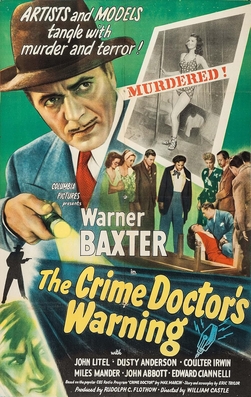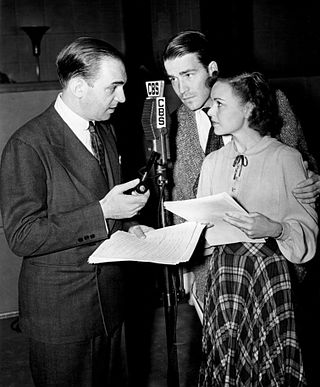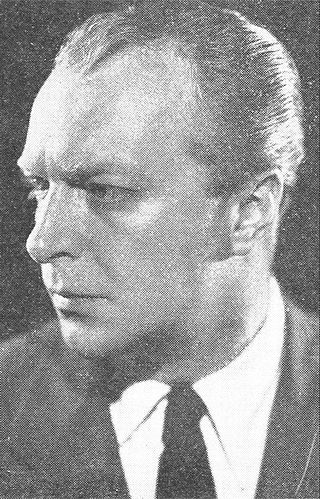Related Research Articles

Edgar Montilion "Monty" Woolley was an American film and theater actor. At the age of 50, he achieved a measure of stardom for his role in the 1939 stage play The Man Who Came to Dinner and its 1942 film adaptation. His distinctive white beard was his trademark and he was affectionately known as "The Beard."
The Whistler is an American radio mystery drama which ran from May 16, 1942, until September 22, 1955, on the west-coast regional CBS radio network. The show was also broadcast in Chicago and over Armed Forces Radio. On the west coast, it was sponsored by the Signal Oil Company: "That whistle is your signal for the Signal Oil program, The Whistler." There were also two short-lived attempts to form east-coast broadcast spurs: July 3 to September 25, 1946, sponsored by the Campbell Soup Company; and March 26, 1947, to September 29, 1948, sponsored by Household Finance. The program was also adapted into a film noir series by Columbia Pictures in 1944.

Dr. James Kildare is a fictional American medical doctor, originally created in the 1930s by the author Frederick Schiller Faust under the pen name Max Brand. Shortly after the character's first appearance in a magazine story, Paramount Pictures used the story and character as the basis for the 1937 film Internes Can't Take Money, starring Joel McCrea as Jimmie Kildare. Metro-Goldwyn-Mayer (MGM) subsequently acquired the rights and featured Kildare as the primary character in a series of American theatrical films in the late 1930s and early 1940s. Several of these films were co-written by Faust, who also continued to write magazine stories and novels about the character until the early 1940s. Kildare was portrayed by Lew Ayres in nine MGM films. Later films set in the same hospital featured Dr. Gillespie. Ayres returned to voice the Kildare character in an early 1950s radio series. The 1961–1966 Dr. Kildare television series made a star of Richard Chamberlain and gave birth to a comic book and comic strip based on the show. A short-lived reboot of the TV series, Young Doctor Kildare, debuted in 1972 and ran for 24 episodes.

John Herrick McIntire was an American character actor who appeared in 65 theatrical films and many television series. McIntire is well known for having replaced Ward Bond, upon Bond's sudden death in November 1960, as the star of NBC's Wagon Train. He played Christopher Hale, the leader of the wagon train from early 1961 to the series' end in 1965. He also replaced Charles Bickford, upon Bickford's death in 1967, as ranch owner Clay Grainger on NBC's The Virginian for four seasons.

William Nettles Goodwin, was an American radio announcer and actor. He was for many years the announcer and a recurring character of the Burns and Allen radio program, and subsequently The George Burns and Gracie Allen Show on television from 1950–1951. Upon his departure, he was replaced by Harry von Zell.

Amzie Ellen Strickland was an American character actress who began in radio, made some 650 television appearances, had roles in two dozen films, appeared in numerous television movies, and also worked in TV commercials.

Crime Doctor (1943) is a crime film adapted from the radio series of the same name. The film stars Warner Baxter as a man with amnesia determined to remember his past. As with the radio series, the film deals with the complex issues of mental health and moral responsibility in the criminal-justice system. The film was released by Columbia Pictures.
The Crime Doctor is a fictional character created by Max Marcin. Criminal Phil Morgan suffers amnesia and becomes criminal psychologist Dr. Ordway. He uses his expertise to solve crimes as well as to help patients.

Big Sister was a daytime radio drama series created by Lillian Lauferty and broadcast on CBS from September 14, 1936, to December 26, 1952. It was sponsored by Lever Brothers for Rinso until 1946 when Procter & Gamble became the sponsor.

Crime Doctor's Warning is a 1945 American mystery film directed by William Castle, and fourth in the Crime Doctor series of ten films produced between 1943 and 1949.
Eric Taylor was an American screenwriter with over fifty titles to his credit. He began writing crime fiction for the pulps before working in Hollywood. He contributed scripts to The Crime Club, Crime Doctor, Dick Tracy, Ellery Queen, and The Whistler series, as well as six Universal monster movies.
Philip Morris Playhouse is a 30-minute old-time radio dramatic anthology series.

The Adventures of Ellery Queen was a radio detective program in the United States. Several iterations of the program appeared on different networks, with the first one broadcast on CBS on June 18, 1939, and the last on ABC on May 27, 1948.
Famous Jury Trials is a radio court show/dramatic anthology series in the United States. It began on January 5, 1936, and ended June 25, 1949. It is considered one of the first programs that initiated the court show genre, which later was broadcast on television as Famous Jury Trials.

Barbara Weeks was an American actress and voice talent in the Golden Age of Radio. She was best known for her work in soap operas.

Staats Cotsworth was an American actor in old-time radio. He is perhaps best known for playing the title role in Casey, Crime Photographer.
The Crime Doctor's Strangest Case is a 1943 American mystery film directed by Eugene Forde and starring Warner Baxter, Lynn Merrick and Gloria Dickson. It is the second in a series of Crime Doctor films made by Columbia Pictures.

Joyce Jordan, M.D. is a 1938-1955 radio soap opera in the United States. It was broadcast on ABC, CBS and NBC at various times during the era of old-time radio.
Danger, Dr. Danfield is an American old-time radio crime drama. It was broadcast on ABC from August 18, 1946, to April 13, 1947, and was syndicated for several years thereafter.

The Story of Mary Marlin is an American soap opera radio program. It was broadcast from October 3, 1934, until April 12, 1945, and returned from September 24, 1951, until April 11, 1952. After 1937 it was among the highest-rated soap operas. A version was also broadcast in Australia in 1959-1960.
References
- 1 2 3 4 5 6 7 Dunning, John (1998). On the Air: The Encyclopedia of Old-Time Radio (Revised ed.). New York, NY: Oxford University Press. pp. 185–186. ISBN 978-0-19-507678-3 . Retrieved 2019-09-17.
- 1 2 Dunning, John. (1976). Tune in Yesterday: The Ultimate Encyclopedia of Old-Time Radio, 1925-1976. Prentice-Hall, Inc. ISBN 0-13-932616-2. P. 149.
- ↑ "Crime Doctor". Radio Mirror. 26 (6): 46–50. November 1946. Retrieved 9 July 2014.
- ↑ "KFPY ad". Spokane Daily Chronicle. September 27, 1943. Retrieved 11 July 2014.
- 1 2 "Radio Drama Reaches the Screen with Real-Life Crime Background". The Montreal Gazette. September 28, 1943. Retrieved 9 July 2014.
- ↑ Radcliff, Marion (February 20, 1943). "Walk into My Parlor". The Billboard. p. 6. Retrieved 11 July 2014.
- ↑ "'Crime Doctor' on Coast". Broadcasting. October 26, 1942. Retrieved 11 July 2014.
- 1 2 Wilt, David (1991). Hardboiled in Hollywood. Bowling Green State University Popular Press. ISBN 0-87972-525-7. P. 77.
- ↑ Banks, Dale (December 1945). "What's New from Coast to Coast". Radio Mirror. 25 (1): 11. Retrieved 12 July 2014.
- ↑ Buxton, Frank and Owen, Bill (1972). The Big Broadcast: 1920-1950. The Viking Press. SBN 670-16240-x. Pp. 63-64.
- ↑ "Jerome Joins Crime Doctor Series as McIntire Retires". Harrisburg Telegraph. Harrisburg Telegraph. June 13, 1942. p. 24. Retrieved April 17, 2015– via Newspapers.com.

- 1 2 Terrace, Vincent (1981), Radio's Golden Years: The Encyclopedia of Radio Programs 1930-1960. A.S. Barnes & Company, Inc. ISBN 0-498-02393-1. P. 65.
- ↑ "Behind the Mike". Broadcasting. October 5, 1942. Retrieved 8 July 2014.